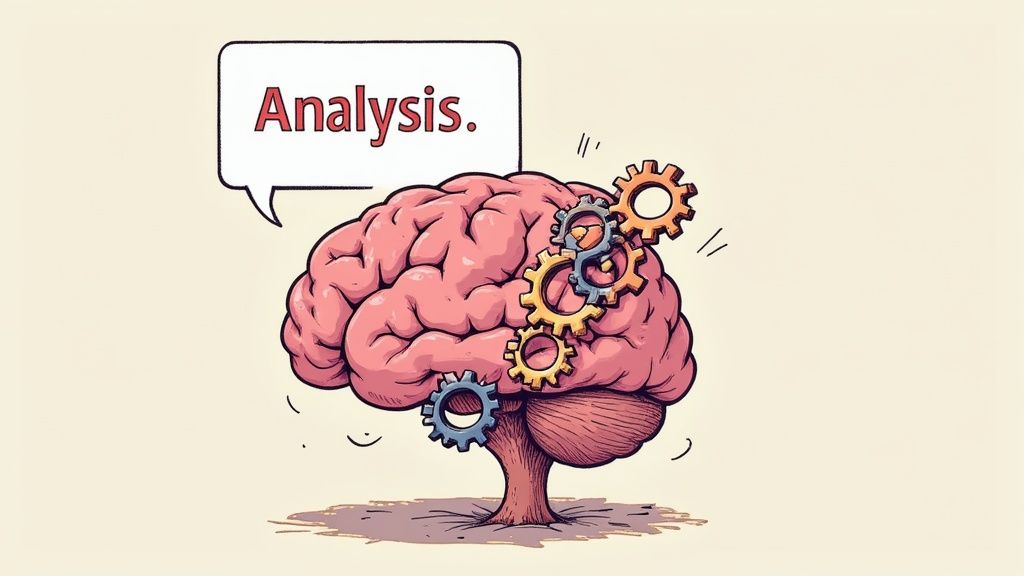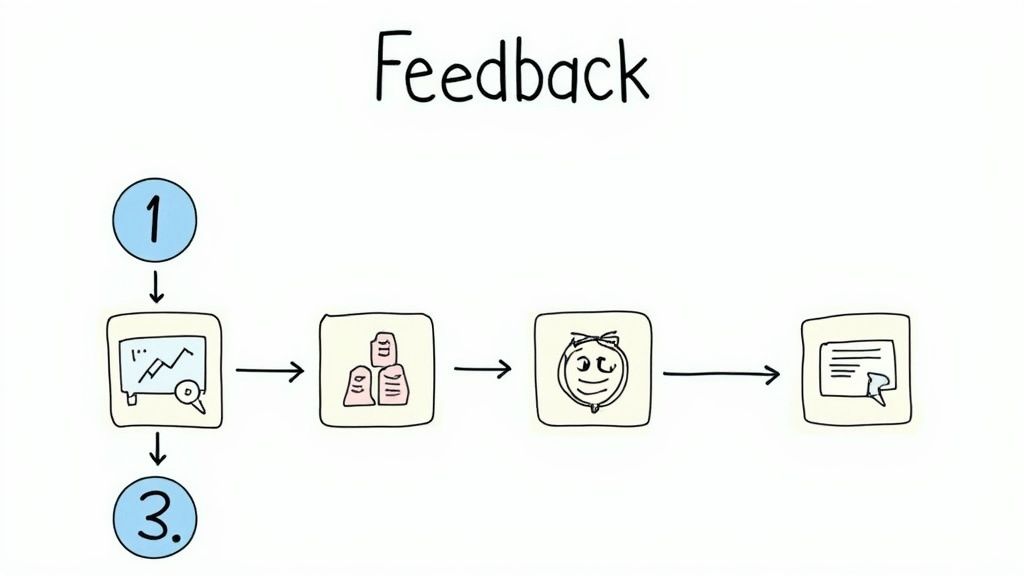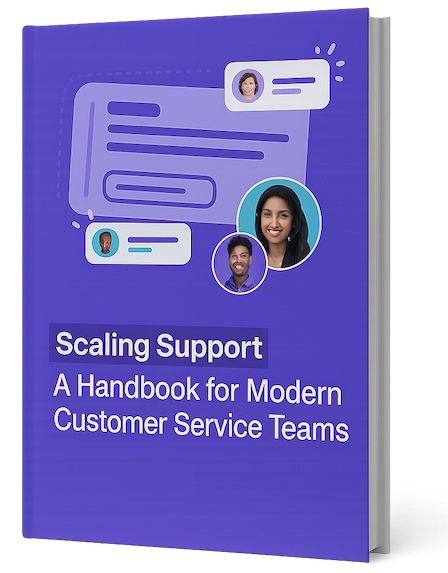When it comes to improving your business, analyzing customer feedback is essential. This requires more than just reading comments – you need a structured way to turn feedback into practical improvements. Understanding the key principles behind feedback analysis helps create an effective process.
Qualitative vs. Quantitative Data: Two Sides of the Same Coin
Customer feedback comes in two main forms: qualitative and quantitative data. Qualitative feedback gives rich, descriptive insights into why customers behave certain ways. This often comes through surveys, interviews and focus groups. For example, a customer might explain why a complex checkout process frustrated them. While these insights are valuable, analyzing lots of qualitative feedback can be challenging.
Quantitative data focuses on numbers and metrics, like customer satisfaction scores (CSAT), Net Promoter Scores (NPS), and churn rates. These numbers are easier to track but may not tell the full story behind customer issues.
Using both types of data gives you the most complete picture. While qualitative feedback helps identify specific pain points, it can be harder to analyze at scale. Numerical data is simpler to measure but may miss important context. Tools like text and sentiment analysis can help quantify qualitative feedback for more reliable analysis. Learn more about combining feedback types at SentiSum.
Categorizing Feedback for Actionable Insights
Organizing feedback into clear categories is crucial for spotting patterns. Group similar comments into themes like “website issues”, “product features”, or “support experience”. Create sub-categories like “slow loading” under websites or “unhelpful agents” under support. This structure helps reveal the biggest opportunities for improvement.
From Collection to Action: Building a Feedback Loop
Rather than a one-time project, feedback analysis works best as an ongoing cycle. Build a feedback loop to continuously gather insights from surveys, reviews, and social media. Analyze and categorize the data to find key improvement areas. Make changes based on what you learn, then start the cycle again. This commitment to constant refinement leads to better customer experiences over time.
Mastering Sentiment Analysis for Deeper Understanding
Sentiment analysis helps you truly understand your customers’ feedback beyond just reading their words. By combining human insight with smart tools, you can uncover the real emotions and opinions behind customer comments.
Why Sentiment Matters
By analyzing customer sentiment, you can spot how people really feel about your business. This helps you catch problems early, find new opportunities, and see if customers are happy overall. For example, if lots of negative comments suddenly appear about a new feature, you’ll know it needs fixing.
Techniques for Sentiment Analysis
Here are the key ways to analyze sentiment in customer feedback:
- Categorization: Label each piece of feedback as positive, negative, or neutral to understand overall patterns.
- Pattern Spotting: Look for common themes and emotional trends. This shows what’s driving good and bad feelings. For example, if many customers complain about shipping delays, that area needs attention.
- Context Understanding: Consider the full picture around each comment, including customer history and specific situations. This helps avoid misunderstanding what customers mean.
The analysis process involves sorting feedback into positive, negative, or neutral groups. You can do this by hand or use software tools. While automated tools can handle large amounts of feedback quickly, human review catches subtle meanings that computers might miss. Many companies use both approaches – letting software handle most feedback while people review the most important or complex responses. See more data here: The Ultimate Guide to Customer Feedback Data.
Balancing Automated and Manual Analysis
While software tools offer speed, human review adds important understanding. Finding the right mix of both approaches leads to the most useful insights.
Here’s a practical way to balance them:
- High Volume: Use software tools like Supportman for quick basic sorting of large amounts of feedback.
- Complex Cases: Have trained team members review tricky or nuanced feedback that needs human judgment.
- Critical Issues: Prioritize human review of very negative or sensitive feedback to fully understand the problems.
This combined approach gives you both speed and deep understanding. It helps you truly learn from customer feedback to make real improvements that matter. Your team can then focus on using these insights to give customers a better experience.
Building a Powerful Feedback Collection Engine
Getting meaningful customer feedback takes more than just occasional surveys. A well-designed feedback system helps you systematically collect and analyze customer insights from every interaction point.
Strategically Designing Your Feedback System
Leading companies gather feedback from multiple touchpoints to understand the full customer experience. Here are key feedback sources to include:
- Support tickets: Direct feedback about specific product and service issues
- Social media comments: Real-time insights into customer sentiment
- Product reviews: Unfiltered perspectives on what works and what doesn’t
- In-app feedback: Contextual data about the user experience
Maximizing Response Rates and Quality
Getting enough high-quality responses is essential for meaningful analysis. Try these proven approaches:
- Smart incentives: Small rewards can boost participation rates
- Simple surveys: Keep them brief and mobile-friendly
- Personal outreach: Use the customer’s name and reference their specific experience
Using consistent rating scales and question formats across channels makes analysis simpler and results more reliable.
Turning Raw Feedback into Actionable Data
The goal isn’t just collecting feedback – it’s gaining insights you can act on. Start by gathering data systematically from surveys, support interactions, social media, and reviews. Tools like Usersnap can help streamline this process.
Group feedback into clear themes like “website navigation” or “product performance.” Break these down further into specific issues – for example, “slow loading times” under performance.
Focus first on the most common issues that affect customer satisfaction. When a retail site discovered checkout problems were frustrating customers, they simplified the process and saw 25% fewer abandoned carts. Keep measuring results as you make changes. Supportman and similar tools can help integrate feedback directly into your workflow for easier tracking and follow-up.
Using Technology to Analyze Customer Feedback

Getting meaningful insights from customer feedback requires more than just reading through comments. The right tools and processes help you uncover patterns and trends that would be hard to spot manually. Here’s how to set up an effective system for analyzing customer feedback.
Selecting the Right Tools
Your choice of feedback analysis tools should match your needs and resources. Here are the main options:
- Basic Tools: Small businesses can start with spreadsheets and simple survey platforms for basic categorization and analysis
- Dedicated Platforms: Growing companies benefit from specialized feedback platforms with built-in analytics and reporting
- Advanced Solutions: Large organizations often need AI-powered tools to handle high volumes of feedback efficiently and identify key themes automatically
For example, Supportman connects with Slack to analyze feedback in real-time, while Microsoft 365 Copilot can process feedback data in Excel to surface important trends.
Creating a Connected Workflow
Having the right tools is just the start – they need to work together smoothly. Connect your survey platform to your CRM to automatically capture feedback. Link analysis tools to communication channels so insights reach the right people quickly.
A fragmented system creates data silos and wastes time. The goal is to have feedback flow naturally through your tools and processes, making insights easily accessible to everyone who needs them.
Automating Regular Tasks
Many aspects of feedback analysis can be automated:
- Categorizing feedback by topic
- Detecting sentiment (positive/negative)
- Identifying common themes and patterns
- Generating summary reports
This frees up your team to focus on understanding the insights and taking action. Modern AI tools excel at processing large volumes of feedback quickly and consistently.
Building for Growth
Your feedback analysis system should scale as your business grows. A few key principles:
- Start with cloud-based tools that can handle increasing data volumes
- Document your processes so new team members can get up to speed quickly
- Regularly review and optimize your workflow
- Focus on gathering actionable insights that drive improvements
The right combination of tools and processes helps you make better use of customer feedback without overwhelming your team. Keep refining your approach based on what works best for your specific needs.
Converting Insights into Business Impact

Collecting customer feedback is important, but the real value comes from using those insights to drive specific improvements. Let’s explore how to take feedback and create measurable business results.
Making Smart Choices About What to Change First
Smart companies use a clear system to decide which feedback-driven changes to make first. Key considerations include how many customers are impacted and how serious the issue is. A minor website tweak requested by a few users might be less urgent than fixing a major product issue affecting many customers.
When evaluating potential changes, look at factors like customer impact, revenue potential, and resource requirements. Build a solid business case using your feedback data to justify investments and get the resources you need.
Creating a Customer-First Team Culture
Your team needs to feel empowered to act on customer insights. Share wins by highlighting positive customer comments about changes you’ve made. Keep measuring results, both big and small, to show why customer feedback matters.
Supportman helps teams stay focused on customers by making feedback visible right in Slack. This leads to faster responses and better collaboration around customer needs.
Tracking Your Results
To prove your changes are working, monitor key metrics before and after implementation. Focus on specific measures like customer satisfaction scores, Net Promoter Score, churn rate, and conversion rates. These numbers show the direct business value of acting on feedback.
A real example: When feedback showed customers were confused about pricing, one company simplified their pricing page. The result? A clear increase in conversion rates that proved the value of listening to customers.
Real Success Stories
Here are some companies that made significant gains by acting on customer feedback:
- A software company fixed key bugs based on user reports, leading to a 15% boost in customer retention
- A retail business revamped their returns process after customer input, reducing complaints by 20%
- A B2B company refined their messaging using feedback, generating 10% more qualified leads
These examples show how systematically collecting and acting on feedback drives real business growth. The key is having a clear process to gather insights and turn them into specific improvements. Companies that master this cycle consistently outperform those who just collect data without taking action.
Creating Sustainable Success Through Continuous Improvement
Building a successful business requires constant growth and adaptation. The foundation lies in effectively analyzing customer feedback – not just collecting it, but creating clear systems that turn insights into meaningful actions.
Developing Meaningful Metrics: Measuring What Matters
Tracking the right metrics helps you understand feedback’s real impact. Focus on both quick wins and long-term progress indicators. For example, fewer complaints about a specific feature shows immediate improvement, while changes in customer lifetime value (CLTV) reveal the lasting effects of feedback-driven changes.
Look beyond surface-level numbers to data that connects directly to business goals. The Net Promoter Score (NPS) offers valuable insight into customer loyalty and likelihood to recommend. Regular NPS tracking, combined with analyzing the feedback behind the scores, helps predict future growth potential.
Maintaining Momentum: Keeping the Feedback Engine Running
A sustainable feedback program needs consistent effort and smart planning. Set clear benchmarks and celebrate team wins to keep energy high. For instance, recognizing team members who use customer feedback to improve processes helps build a culture focused on getting better every day.
Create smooth feedback loops that fit naturally into your existing work. Tools like Supportman make this easier by connecting customer feedback directly to platforms like Slack, putting insights right where your team needs them.
Building a Culture of Feedback: Empowering Your Team
Top organizations make feedback central to their work culture. Give every team member the tools and training to analyze feedback and act on insights. This means fostering open discussions and making feedback part of the daily workflow.
Include feedback analysis in team meetings and reviews to show its importance. This helps create an environment where teams actively seek input and value customer perspectives. When feedback becomes part of your company’s DNA, you build stronger customer relationships and drive real growth.
Ready to put your customer feedback to work? Try Supportman and see how real-time feedback integration can help your team grow. Start your free trial now!


